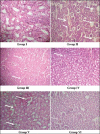Study of antiurolithiatic activity of Asparagus racemosus on albino rats
- PMID: 23112416
- PMCID: PMC3480787
- DOI: 10.4103/0253-7613.100378
Study of antiurolithiatic activity of Asparagus racemosus on albino rats
Abstract
Aims: The aim of this study was to investigate the effect of ethanolic extract of Asparagus racemosus on urolithiasis in rats.
Materials and methods: Thirty-six male Wistar albino rats were randomly divided into six groups (n = 6). Ethylene glycol (EG) 0.75% and ammonium chloride (AC) 2% in drinking water were fed to all groups (Groups II-VI) except normal control (Group I) rats for 10 days to induce urolithiasis. Group III-VI rats were treated with ethanolic extract of Asparagus racemosus at doses 200, 400, 800, and 1600 mg/kg, respectively, for 10 days. Positive control (Group II) rats were treated with EG/AC alone. Group I rats were administered drinking water and distilled water (6 μl/g) by gavage. After 10 days, blood samples were collected and analyzed for serum concentrations of calcium, phosphorus, urea, and creatinine. The kidneys were removed and sectioned for histopathological examination. The data were presented as mean ± standard error of mean and analyzed using one-way analysis of variance and Student's "t"-test. P < 0.05 was considered statistically significant. Conventional windows software was used for statistical analysis.
Results: The rats treated with ethanolic extract of A. racemosus at doses 800 and 1600 mg/ kg significantly (P < 0.05) reduced the serum concentrations of calcium, phosphorus, urea, and creatinine. Histopathology of the kidneys in Groups V and VI revealed less tissue damage and were almost similar to Group I rats.
Conclusions: The ethanolic extract of A. racemosus has protective effect against urolithiasis.
Keywords: Ammonium chloride; Asparagus racemosus; antiurolithiatic activity; ethylene glycol.
Conflict of interest statement
Figures
Similar articles
-
Antiurolithiatic and antioxidant activity of Hordeum vulgare seeds on ethylene glycol-induced urolithiasis in rats.Indian J Pharmacol. 2012 Nov-Dec;44(6):672-7. doi: 10.4103/0253-7613.103237. Indian J Pharmacol. 2012. PMID: 23248392 Free PMC article.
-
Antiurolithiatic activity of ethanol leaf extract of Ipomoea eriocarpa against ethylene glycol-induced urolithiasis in male Wistar rats.Indian J Pharmacol. 2016 May-Jun;48(3):270-4. doi: 10.4103/0253-7613.182886. Indian J Pharmacol. 2016. PMID: 27298496 Free PMC article.
-
Antilithiatic effect of Asparagus racemosus Willd on ethylene glycol-induced lithiasis in male albino Wistar rats.Methods Find Exp Clin Pharmacol. 2005 Nov;27(9):633-8. doi: 10.1358/mf.2005.27.9.939338. Methods Find Exp Clin Pharmacol. 2005. PMID: 16357948
-
Asparagus racemosus--an update.Indian J Med Sci. 2003 Sep;57(9):408-14. Indian J Med Sci. 2003. PMID: 14515032 Review.
-
Neuro-nutraceutical potential of Asparagus racemosus: A review.Neurochem Int. 2021 May;145:105013. doi: 10.1016/j.neuint.2021.105013. Epub 2021 Mar 6. Neurochem Int. 2021. PMID: 33689806 Review.
Cited by
-
Antiurolithic effects of medicinal plants: results of in vivo studies in rat models of calcium oxalate nephrolithiasis-a systematic review.Urolithiasis. 2021 Apr;49(2):95-122. doi: 10.1007/s00240-020-01236-0. Epub 2021 Jan 23. Urolithiasis. 2021. PMID: 33484322
-
Literature analysis on asparagus roots and review of its functional characterizations.Front Nutr. 2023 Apr 17;9:1024190. doi: 10.3389/fnut.2022.1024190. eCollection 2022. Front Nutr. 2023. PMID: 37139102 Free PMC article. Review.
-
Adaptogenic property of Asparagus racemosus: Future trends and prospects.Heliyon. 2023 Apr 1;9(4):e14932. doi: 10.1016/j.heliyon.2023.e14932. eCollection 2023 Apr. Heliyon. 2023. PMID: 37095959 Free PMC article. Review.
-
Antiurolithiatic and antioxidant efficacy of Musa paradisiaca pseudostem on ethylene glycol-induced nephrolithiasis in rat.Indian J Pharmacol. 2017 Jan-Feb;49(1):77-83. doi: 10.4103/0253-7613.201026. Indian J Pharmacol. 2017. PMID: 28458427 Free PMC article.
References
-
- Marshall L, Stoller MD. Urinary stone disease. In: Tanagho EA, McAninch JW, editors. Smith's General Urology. 16th ed. New York: McGraw-Hill Lange Medical Books; 2004. pp. 256–91.
-
- Khan SR. Interactions between stone-forming calcific crystals and macromolecules. Urol Int. 1997;59:59–71. - PubMed
-
- Atmani F, Slimani Y, Mimouni M, Hacht B. Prophylaxis of calcium oxalate stones by Herniaria hirsute on experimentally induced nephrolithiasis in rats. BJU Int. 2003;92:137–40. - PubMed
-
- Suman KM, Satyaranjan M, Sabuj S, Prasannakumar P. Antiurolithiatic activity of Cratavera manga Lour.bark. Indian J Nat Prod Resour. 2011;2:28–33.
MeSH terms
Substances
LinkOut - more resources
Full Text Sources


